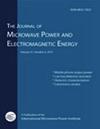Different heat treatments and sealing effect on the nutritive value of Lucerne hay
IF 1.5
4区 工程技术
Q4 ENGINEERING, CHEMICAL
Journal of Microwave Power and Electromagnetic Energy
Pub Date : 2022-04-03
DOI:10.1080/08327823.2022.2066773
引用次数: 0
Abstract
Abstract This study investigated the comparative effects of conventional hot-air oven heating (CHO), microwave heating (MW) and sealing effect on the nutritive value of lucerne hay. Equivalent energy (125 J.g−1) was applied with a 1.1 kW of MW oven for 60 seconds (s) or a 3.06 kW CHO oven for 350 s. The required equivalent energy level was measured based on a preliminary calibration trial. Two heating method (CHO and MW) and sealing condition (SC) applied as treatment factors in this study. A two-way analysis of variance (P < 0.05) was used to measure the effect of different factors on some properties of lucerne hay. The dry matter (DM) percentage of lucerne hay was increased when MW treatments were applied on both sealed and non-sealed lucerne hay compared with the control. Both heating method and their interaction with SC had negative effects on crude protein (CP) percentage. DM digestibility (DMD) and Digestible organic matter in the DM (DOMD) were decreased by 9% and 5%, respectively, in the sealed MW group, compared with the sealed control. Neutral detergent fibre % also increased by 6% in the sealed MW group, compared with the sealed control group. However, no differences in acid detergent fibre % due to any heating method and/or SC were observed in this study. The mechanisms behind these changes require further exploration.不同热处理及密封对苜蓿干草营养价值的影响
摘要本试验研究了传统热风炉加热(CHO)、微波加热(MW)和密封处理对苜蓿干草营养价值的影响。等效能量(125 J.g−1)应用于1.1 kW的MW烘箱60秒(s)或3.06 kW的CHO烘箱350秒。所需的等效能级是在初步校准试验的基础上测量的。采用两种加热方式(CHO和MW)和密封条件(SC)作为处理因素。采用双向方差分析(P < 0.05)衡量不同因素对苜蓿干草部分性状的影响。与对照相比,密封和未密封苜蓿干草施用MW处理均提高了苜蓿干草的干物质(DM)百分比。加热方式及与SC的互作均对粗蛋白质(CP)率产生负向影响。与密封对照组相比,密封MW组DM消化率(DMD)和DM可消化有机质(DOMD)分别降低了9%和5%。与密封的对照组相比,密封的MW组中性洗涤纤维%也增加了6%。然而,在本研究中没有观察到任何加热方法和/或SC对酸性洗涤纤维百分比的影响。这些变化背后的机制需要进一步探索。
本文章由计算机程序翻译,如有差异,请以英文原文为准。
求助全文
约1分钟内获得全文
求助全文
来源期刊

Journal of Microwave Power and Electromagnetic Energy
ENGINEERING, CHEMICAL-ENGINEERING, ELECTRICAL & ELECTRONIC
CiteScore
2.50
自引率
6.70%
发文量
21
期刊介绍:
The Journal of the Microwave Power Energy (JMPEE) is a quarterly publication of the International Microwave Power Institute (IMPI), aimed to be one of the primary sources of the most reliable information in the arts and sciences of microwave and RF technology. JMPEE provides space to engineers and researchers for presenting papers about non-communication applications of microwave and RF, mostly industrial, scientific, medical and instrumentation. Topics include, but are not limited to: applications in materials science and nanotechnology, characterization of biological tissues, food industry applications, green chemistry, health and therapeutic applications, microwave chemistry, microwave processing of materials, soil remediation, and waste processing.
 求助内容:
求助内容: 应助结果提醒方式:
应助结果提醒方式:


